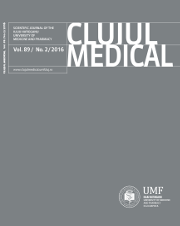Breast cancer stem-like cells: Clinical implications and therapeutic strategies
DOI:
https://doi.org/10.15386/cjmed-559Keywords:
cancer stem-like cells, breast cancer, signaling pathways, targeting strategiesAbstract
Breast cancer is the most frequently diagnosed cancer in women, being also the leading cause of cancer death among female population, including in Romania. Resistance to therapy represents a major problem for cancer treatment. Current cancer treatments are both expensive and induce serious side effects; therefore ineffective therapies are both traumatic and pricy. Characterizing predictive markers that can identify high-risk patients could contribute to dedicated/personalized therapy to improve the life quality and expectancy of cancer patients. Moreover, there are some markers that govern specific tumor molecular features that can be targeted with specific therapies for those patients who are most likely to benefit. The identification of stem cells in both normal and malignant breast tissue have lead to the hypothesis that breast tumors arise from breast cancer stem-like cells (CSCs), and that these cells influence tumor’s response to therapy. CSCs have similar self-renewal properties to normal stem cells, however the balance between the signaling pathways is altered towards tumor formation In this review, we discuss the molecular aspects of breast CSCs and the controversies regarding their use in the diagnosis and treatment decision of breast cancer patients.Downloads
Additional Files
Published
2016-04-21
How to Cite
1.
Tudoran OM, Balacescu O, Berindan-Neagoe I. Breast cancer stem-like cells: Clinical implications and therapeutic strategies. Med Pharm Rep [Internet]. 2016 Apr. 21 [cited 2025 Dec. 27];89(2):193-8. Available from: https://medpharmareports.com/index.php/mpr/article/view/559
Issue
Section
Reviews
License
The authors are required to transfer the copyright of the published paper to the journal. This is done by agreeing to sign the Copyright Assignment Form. Whenever the case, authors are also required to send permissions to reproduce material (such as illustrations) from the copyright holder.

The papers published in the journal are licensed under a Creative Commons Attribution-NonCommercial-NoDerivatives 4.0 International License.

